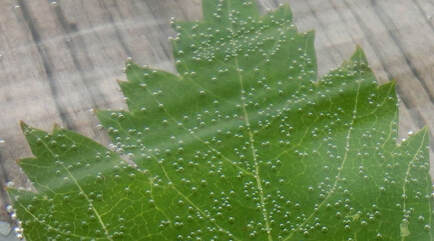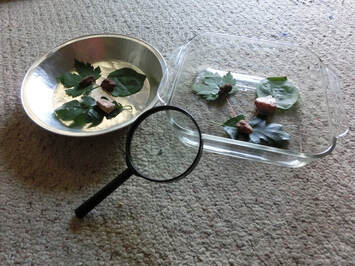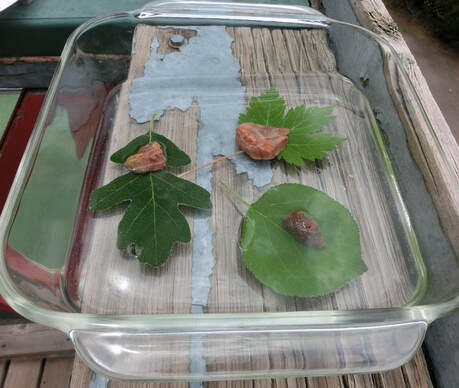Click and expand the tabs below to get started.
Experimental procedure
what's happening
Trees and other plants need to "breathe" air and "drink" water in order to grow, just as we do, but when the sun shines on them they can do something that we can't do. It's an amazing chemical reaction called photosynthesis. Cells in the plant's leaves get carbon dioxide gas molecules, or CO2, from the air, and water molecules, or H2O, from their roots. These cells also contain special structures called chloroplasts which in turn contain a chemical called chlorophyll, which is the pigment that gives the leaves their green color.
The chlorophyll in chloroplasts can absorb sunlight and use its energy to split apart the hydrogen (H) and oxygen (O) atoms of H2O molecules (just like you might use your energy to break apart the individual pieces of a Lego car). Another part of the cell breaks apart the carbon (C) and oxygen (O) atoms of CO2. Now the cell can use some of these H, C and O atoms to rebuild new molecules called carbohydrates (just like you could build a new boat or plane with the Lego pieces from your car). Some common carbohydrates made by plants include glucose (used for energy), cellulose (used for building leaves and stems) and starch (used to store extra energy). After building these new carbohydrate molecules it turns out that there are some extra oxygen atoms left over, which simply escape through the leaves, just like we exhale when we breathe. We breathe in oxygen and exhale carbon dioxide, while plants breathe in carbon dioxide and exhale oxygen during photosynthesis, thus we need each other to survive. [Plants can also breathe in oxygen and exhale carbon dioxide and water, just like we do. This process is called plant or cellular respiration.] If you look closely at your leaves that were in the sunlight, you should see lots of very tiny bubbles. These are the escaping oxygen atoms which form bubbles since they are under water. If you look closely at the leaves that were kept in the dark, however, you won't see any bubbles. This shows that without sunlight the plant does not have the energy it needs for photosynthesis, thus it can't split apart the atoms of the H2O molecules and there are no oxygen atoms to escape through the leaves.
variations and related activities
references and links to more information
These links will get you started on your own internet search to learn more
Learn more about photosynthesis and chlorophyll:
Learn more about plant and leaf science (botany):
Learn about plant cells:
More experiments with plants and cells:
Identifying plants and trees by their leaves:
Learn more about carbohydrates:
Click here to ask a question or leave a comment
8 Comments
Brian Mooney
5/3/2022 06:32:44 pm
Elegant in its simplicity and clarity! Awesome, indeed!
Reply
Brian Mooney
5/3/2022 07:17:06 pm
This demonstration badly needs a control! This is a critical point.
Reply
7/4/2022 03:39:29 am
Wow, great post! This will surely be a perfect little experiment with the kids.
Reply
10/31/2022 07:55:19 am
this is really intresting i didnt know that leaves breathed like people and animals did anyways i will definetly be doing this experiment
Reply
Thank you for sharing this interesting article on leaf bubbles! I had no idea that this phenomenon even existed! It's fascinating to learn about all the ways that plants interact with their environment. I'm particularly intrigued to learn that leaf bubbles can provide insight into the health of a plant or something as simple as a windy day. I'm looking forward to finding out more about this and other cool and unique aspects of the natural world.
Reply
Your comment will be posted after it is approved.
Leave a Reply. |










